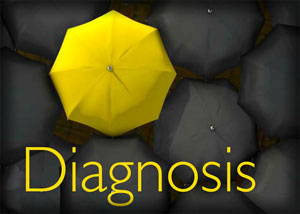Discuss this article on the forums
 One of the biggest questions awaiting the new definition for myalgic encephalomyelitis (ICC) is who fits it vs who fits the standard definition for CFS. The ICC authors believe that people who meet their criteria may have a different sort of illness than people who meet the Fukuda definition but who do not meet the ICC definition. Future studies will hopefully determine whether that is true or not.
One of the biggest questions awaiting the new definition for myalgic encephalomyelitis (ICC) is who fits it vs who fits the standard definition for CFS. The ICC authors believe that people who meet their criteria may have a different sort of illness than people who meet the Fukuda definition but who do not meet the ICC definition. Future studies will hopefully determine whether that is true or not.
We should note that the ICC was produced by the agreement of ME professionals. Dr. Leonard Jason is currently using statistical analyses to determine symptom criteria. His criteria will probably differ in some aspects from the ICC criteria.
in this poll we ask you to look at both definitions and determine which one(s) you meet.
Fukuda Criteria for CFS (1994)
The Fatigue Requirements
- Unexplained persistent or relapsing fatigue that had a definite onset (is not lifelong)
- Is not the result of ongoing exertion and is not substantially alleviated by rest.
- Results in a substantial reduction in previous levels of occupational, educational, social or personal activities.
Plus you must also have four or more of the following symptoms each of which must have showed up with the illness and not before.
- Impairment in short-term memory or concentration
- sore throat
- Tender lymph nodes in the neck or shoulders
- muscle pain
- multi-joint pain without joint swelling or redness
- headaches of a new type, pattern, or severity;
- unrefreshing sleep;
- post-exertional malaise lasting more than 24 hours.
International Consensus Criteria (ICC) For ME (2011)
The ICC criteria are much more complex; to meet them you MUST meet the Exertion Requirements
Post-exertional neuroimmune exhaustion (PENE) which involves rapid physical or mental fatigability in response to exertion, increased symptoms after exertion and prolonged recovery periods (usually 24 hours or more) and substantially reduced activity levels
Plus you must have at least seven more symptoms spread across 10 categories….To be specific you need to have
PLUS ONE symptom from THREE of the next FOUR symptom categories….(neurocognitive impairments, Pain, Sleep Disturbance and Neurosensory, Perceptual and Motor Disturbances
Neurocognitive Impairments – slowed thought, impaired concentration e.g. confusion, disorientation, cognitive overload, difficulty with making decisions, slowed speech, acquired or exertional dyslexia, short-term memory loss: e.g. difficulty remembering what one wanted to say, what one was saying, retrieving words, recalling information, poor working memory
Pain
- Headaches: e.g. chronic, generalized headaches often involve aching of the eyes, behind the eyes or back of the head that may be associated with cervical muscle tension; migraine;
- tension headaches
- Significant pain experienced in the muscles, muscle-tendon junctions, joints, abdomen or
- chest. It is non-inflammatory in nature and often migrates. e.g. generalized hyperalgesia,
- widespread pain (may meet fibromyalgia criteria), myofascial or radiating pain
Sleep Disturbance
- Disturbed sleep patterns: e.g. insomnia, prolonged sleep including naps, sleeping most of the day and being awake most of the night, frequent awakenings, awaking much earlier than
- before illness onset, vivid dreams/nightmares
- Unrefreshed sleep: e.g. awaken feeling exhausted regardless of duration of sleep, day-time sleepiness
4. Neurosensory, Perceptual and Motor Disturbances
- Neurosensory and perceptual: e.g. inability to focus vision, sensitivity to light, noise,
- vibration, odour, taste and touch; impaired depth perception
- Motor: e.g. muscle weakness, twitching, poor coordination, feeling unsteady on feet, ataxia
PLUS At least One SYMPTOM from THREE of the following five categories (three symptoms total spread out over five categories; Flu-like, Viral Infections, Gastro-intestinal, Sensitivities)
Immune, Gastro-intestinal & Genitourinary Impairments
- Flu-like symptoms may be recurrent or chronic and typically activate or worsen with exertion e.g. sore throat, sinusitis, cervical and/or axillary lymph nodes may enlarge or be tender on palpitation
- Susceptibility to viral infections with prolonged recovery periods
- Gastro-intestinal tract: e.g. nausea, abdominal pain, bloating, irritable bowel syndrome
- Genitourinary: e.g. urinary urgency or frequency, nocturia
- Sensitivities to food, medications, odours or chemicals
PLUS Least ONE SYMPTOM from the Energy Production/Transportation Impairment Category
D. Energy Production/Transportation Impairments: At least One Symptom
- Cardiovascular: e.g. inability to tolerate an upright position – orthostatic intolerance, neurally mediated hypotension, postural orthostatic tachycardia syndrome, palpitations with or without
cardiac arrhythmias, light-headedness/dizziness - Respiratory: e.g. air hunger, laboured breathing, fatigue of chest wall muscles
- Loss of thermostatic stability: e.g. subnormal body temperature, marked diurnal fluctuations; sweating episodes, recurrent feelings of feverishness with or without low grade fever, cold extremities
- Intolerance of extremes of temperature
Now that you’ve determined which criteria you meet please take the poll. You can find the poll here.
